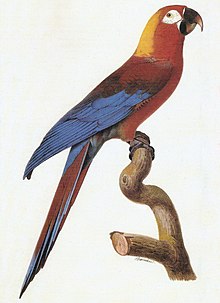
Back مكاو كوبي Arabic Трохкаляровы ара Byelorussian Кубински червен ара Bulgarian কিউবান ম্যাকাও Bengali/Bangla Guacamai de Cuba Catalan Ara tricolor CEB Ara kubánský Czech Kuba-Ara German Ara tricolor Spanish Ara tricolor Basque
| Cuban macaw | |
|---|---|

| |
| Watercolour painting by Jacques Barraband, ca. 1800 | |
| Scientific classification | |
| Domain: | Eukaryota |
| Kingdom: | Animalia |
| Phylum: | Chordata |
| Class: | Aves |
| Order: | Psittaciformes |
| Family: | Psittacidae |
| Genus: | Ara |
| Species: | †A. tricolor
|
| Binomial name | |
| †Ara tricolor (Bechstein, 1811)
| |

| |
| Former distribution in Cuba, including Isla de la Juventud[2] | |
| Synonyms | |
| |
The Cuban macaw or Cuban red macaw (Ara tricolor) is an extinct species of macaw native to the main island of Cuba and the nearby Isla de la Juventud. It became extinct in the late 19th century. Its relationship with other macaws in its genus was long uncertain, but it was thought to have been closely related to the scarlet macaw, which has some similarities in appearance. It may also have been closely related, or identical, to the hypothetical Jamaican red macaw. A 2018 DNA study found that it was the sister species of two red and two green species of extant macaws.
At about 45–50 centimetres (18–20 in) long, the Cuban macaw was one of the smallest macaws. It had a red, orange, yellow, and white head, and a red, orange, green, brown, and blue body. Little is known of its behaviour, but it is reported to have nested in hollow trees, lived in pairs or families, and fed on seeds and fruits. The species' original distribution on Cuba is unknown, but it may have been restricted to the central and western parts of the island. It was mainly reported from the vast Zapata Swamp, where it inhabited open terrain with scattered trees.
The Cuban macaw was traded and hunted by Native Americans, and by Europeans after their arrival in the 15th century. Many individuals were brought to Europe as cagebirds, and 19 museum skins exist today. No modern skeletons are known, but a few subfossil remains have been found on Cuba. It had become rare by the mid-19th century due to pressure from hunting, trade, and habitat destruction. Hurricanes may also have contributed to its demise. The last reliable accounts of the species are from the 1850s on Cuba and 1864 on Isla de la Juventud, but it may have persisted until 1885.
- ^ BirdLife International (2016). "Ara tricolor". IUCN Red List of Threatened Species. 2016: e.T22724513A94870119. doi:10.2305/IUCN.UK.2016-3.RLTS.T22724513A94870119.en. Retrieved 12 November 2021.
- ^ BirdLife International (2012). "Ara tricolor". IUCN Red List of Threatened Species. 2012. Retrieved 26 November 2013.
© MMXXIII Rich X Search. We shall prevail. All rights reserved. Rich X Search
